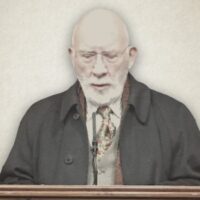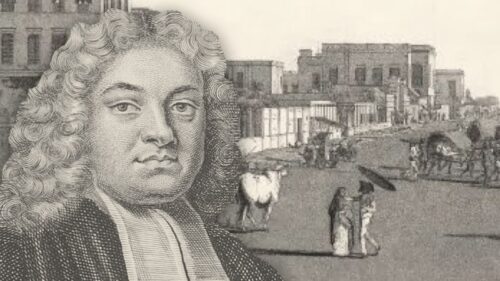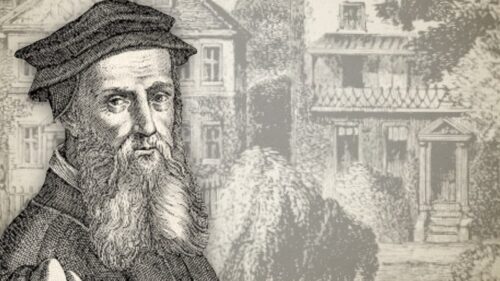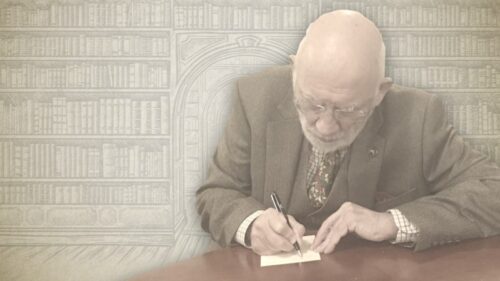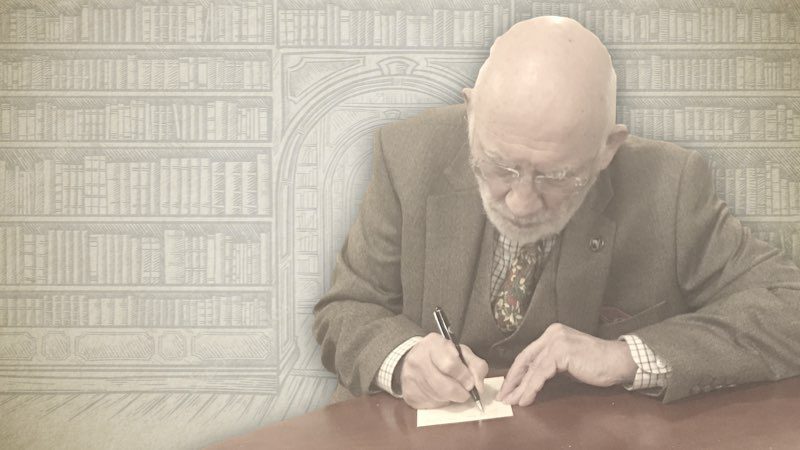
Kiffin, Knollys and Keach: Rediscovering our English Baptist Heritage
The news that Carey Publications were to publish the lives of these three 17th century Baptists filled me with a feeling of hopeful expectancy. The three Ks have aided my own understanding of the ways of God immensely and I know from my correspondents that there is an awakened, wide-spread interest in them. Michael Haykin’s book thus comes at a most appropriate time.
My expectancy was dampened by Robert Oliver’s foreword in which he takes up his pet theme, Hyper-Calvinism, and back-projects it onto the teaching of Kiffin and Co., arguing that they were against it, whereas they had nothing to do with it, or rather, nothing to do with this modern controversy which is forced onto the churches, leaving havoc and destruction in its wake. This raises the question of whether we have an objective study of the three Ks before us, or are they being misused to batter down the Biblical strongholds of those who cannot accept modern re-definitions of Calvinism and the denial of the ‘particular’ nature of the Atonement.
In his introduction, Prof. Haykin mentions the respective importance of the three Particular Baptists in drawing up the London Baptist Confessions, combating the Seekers, introducing hymn-singing and establishing a Biblical Baptist heritage. Some insight is then given into the sources Haykin has used for his work and good friends are thanked for their support. In keeping with the re-classification of the past, hinted at in Oliver’s foreword, though the book deals with Particular Baptists and their heritage, this historical and doctrinally sound title has been dropped and not once are the subjects of this study named with their own honourable name.
In Chapter One, Haykin examines three major theories of Baptist origins. The Successionist view traces the Baptists back to the time of John the Baptist, a view which Haykin interprets as nothing more than a continuation of evangelical witness and claims that the very idea invalidates the ‘succession’ theory as it does not apply specifically to ‘Baptists’ as opposed to Waldensians etc.. Haykin does not allow the Successionists a word, nor does he apparently accept that Successionism is held in various credible versions throughout the Baptist churches. He also does not deal with the extreme high church view of some Successionists as illustrated by D. B. Ray in his book Baptist Succession: A Handbook of Baptist History.
Haykin next considers the theory that Baptists origins are linked with Continental Anabaptists. Haykin denies any ‘direct influence’, quoting B. R. White via K. R. Manley in support. It seems most odd that though Haykin lists Dr. White’s book in the endnotes, i.e. as a work he has studied carefully, he yet quotes him merely from a secondary source. Furthermore, Haykin is obviously neither aware of White’s true position, nor with that of the Particular Baptists concerning the Continental Anabaptists. Even Gill and Spurgeon, when it came to the pinch, identified themselves with the Anabaptists. Actually, White argues, in contrast to Haykin’s version of him, that such a link cannot be ruled out. Indeed, he suggests that such a link is plausible, quoting the findings of Ernest Payne to add weight.[1. The English Baptists of the 17th Century, pp. 21-23.]
Haykin now looks at the ‘Puritan Separatist Descent (not ‘Dissent’) view’ which is the only view he finds acceptable. He sees Baptist origins developing in the Separatist movements of the late 16th and 17th centuries, via controversial figures such as ‘Trouble Church'[2. Browne’s nickname.] Robert Browne, John Penry and John Smyth. The latter’s teaching, through Thomas Helwys, Haykin informs his readers, resulted in the first English-speaking Arminian Baptist church, the ‘Calvinistic’ Baptists (What happened to the PBs?) evolving throughout ‘the next couple of centuries.’
This is a bombshell indeed for Church historians and especially for Particular Baptists. If Haykin’s theory is true, there is no pre-16th century historical basis for any British Baptist and Particular Baptists are to be regarded as a mere later offshoot of political and Arminian unrest. It is odd that Haykin, a professing Calvinist, sees his own Baptist roots in the General Baptists, whereas the usual PB view is that they, themselves, represent true Baptist succession. It must be noted that none of the writers Haykin lists support his argument, nor do any of the works of the three Ks he is supposed to be studying.
In Chapter Two, Haykin examines the development of his ‘Calvinistic Baptists’ stressing again that they ‘appear on the scene after the origin of the General Baptists.’ A mark of these Baptists, we are told, was their introduction of immersion as a testimony of the death, burial and resurrection of the Lord Jesus. Contrary to his previous argument, Haykin now maintains that the Calvinistic Baptists represent the ‘Puritan Separatist Descent view’ better than the General Baptists and cites John Spilbury’s break-off from Henry Jessey’s church in 1638 as ‘the first Calvinist Baptist church.’ Haykin sees the various break-offs from Jessey’s church solely from the point of view of believers’ baptism, as opposed to covenantal, and immersion as opposed to sprinkling. In introducing believer’s Baptism and immersion as novelties and by referring to ‘the fledgling Baptist churches’, which broke-away from Jessey’s church, Haykin is re-writing traditional Baptist history. When Haykin informs us that these break-offs, with Knollys and Kiffin to the fore, were rumoured as using ‘swords, clubs and staves’ to emphasise their difference of opinion and threaten their opponents with murder, he further weakens Baptist credibility. Let us hope that the rumour Haykin picked up was false, but he does not attempt to allay our fears. History ought not to be the science of rumours but of chronicled facts and their outworking in the people of their times.
Chapter Three deals with the First London Confession or 1644 The Articles receive a brief comment but we are not told what part Kiffin and his brethren played in their authorship. Haykin sees the confession as a defence against General Baptist views and accusations of political rebellion. He then examines early Baptists associations but though the three Ks played an important role in this work, and they are the stars of Haykin’s book, none of them is even briefly mentioned.
Haykin starts his biographical work, in Chapter Four, with his William Kiffin, ‘A Lover of Peace and Truth’, arguing that there is ‘no adequate biography’ of Kiffin to be had. However, B. A. Ramsbottom’s work[3. Stranger than Fiction: The Life of William Kiffin, GST Publication, 1989.] has been around for seven years and other works have preceded this sympathetic study. Purchasers of Haykin’s book will be led by the title to expect that such an ‘adequate’ work in the form of Haykin’s book now lies before them, but they are in for a disappointment. As if to underline his lack of source consultation, Haykin deals with Kiffin’s birth and childhood in a single sentence, bringing us up to Kiffin’s adulthood in half a page. The next eight pages deal with Kiffin’s Baptist convictions, his support for Oliver Cromwell his financial support for the Jacobite king and his stand for strict communion. Haykin explains Kiffin’s U-turn on closed communion in Robert Oliver’s words, ‘Disunity was a luxury that they could ill afford.’ This is a confusing passage as Haykin argues that open communion was ‘out of step with most seventeenth-century Calvinistic Baptists,’ yet the 1689 Second London Confession reversed the strict communion findings of the 1644 Confession, allowing for freedom of conscience on the matter. There is a brief biographical paragraph explaining how Kiffin amassed a fortune and the biography ends with just over a page referring to Kiffin’s domestic life and last 12 years. Tucked away in the endnotes, Haykin lists Ramsbottom’s work. One wonders why he has not delved into it and studied it carefully. Kiffin deserves a better portrayal.
Chapter Five deals with Knollys who has badly needed rehabilitation since Cotton Mather read Mr. Hanserd Knollys as ‘Mr. Absurd Knowless.’ Contrary to what became his nickname, he was a very learned man and, after progressing from Anglicanism to Congregationalism, he settling down in Britain as a Baptist and did much useful work. Through the work of the Hanserd Knollys Society, Knollys’ own autobiography, completed by Kiffin, and Brook’s biography in his The Lives of the Puritans, Knollys has become well-known to us. Strangely enough for one praised in Fullerite circles as a most capable and gifted historian, Haykin neither mention the society’s good work, nor Knolly’s autobiography which one would think is essential to a study of Knollys, nor Brooks biography.
Skipping over Knollys’ early life completely, Haykin introduces him at his Anglican ordination. We learn that Knollys ‘ran into trouble with the New England Congregationalists’, but the details, essential to a true picture of Knollys. We find that he joined ‘the fledgling Calvinist Baptist cause’ and proved his Christ-centred spirituality in a sermon entitled Christ Exalted. Knollys was led to pastor a London congregation, drawing some 1,000 hearers. The work in which Knollys played a key part is described by Haykin as ‘a harvest-time for the Calvinistic Baptists’ without further comment.
Now Knollys’ dealings with the Seekers is outlined in which he lays down sound Scriptural rules for acknowledging the work and the gifts of the Spirit in an ordered church life. His views on the Trinitarian management of the gifts are extremely enlightening as also his comfort to misguided gift-seekers that if they have Christ, they have all, therefore they should seek Christ rather than gifts. The four and a half pages on this topic show that Haykin is able to write Christian biography so that the Christian heart wishes to have more. Perhaps Haykin could have outlined that though the Seekers were orthodox on many matters and have our sympathy for their search for a true church, a true ministry and a true usage of the sacraments, when all is summed up, it was their low view of the Word of God as their final authority which caused them to fall.
Knollys’ two periods of imprisonment are described in one sentence and his work with Kiffin for the Second London Confession finds brief mention. Haykin relates how Keach was healed as an answer to Knollys’ prayers and wonders how such prayers could fit in with Knollys denial of ‘extraordinary gifts of the Spirit’. Such requests, one would think, belong to the normal Christians life and thus are not ‘extraordinary’ in Haykin’s sense. Does not Haykin pray for his sick friends without claiming ‘extraordinary gifts of the Spirit’? The chapter’s final paragraph tells us that Knollys died well in his ninety-third year. If Haykin wishes to describe Knollys as the man history shows him to have been and a key figure in the growth of the Particular Baptists, Haykin needs to read up on him more thoroughly.
Haykin dedicates the next two chapter to the purpose and theology of the Second London Confession which, he argues, arose because of the greater degree of toleration for Baptists and their effort to make a united front with other Calvinist denominations. Thus the Westminster Confession, as modified in the Savoy Declaration was taken as the fundament of the new Baptist Confession. Haykin suggests that the Confession was also drawn up to combat Hyper-Calvinism. As odd proof he backs up co-compiler Andrew Clifford’s insistence that every man ought to give God due homage in prayer. This was, of course, equally a firm contention of Haykin’s ‘Hypers’, Gill and Brine who were men of prayer. On studying the Second London Confession in view of Haykin’s faulty understanding of it, we find that the Confession clearly emphasised a Calvinism which Haykin considers ‘Hyper’, Chapter Twenty Of the Gospel, for instance, is far more explicit and accurate in explaining the work of the Reformed preacher that Haykin’s own narrow, misleading version of the Confession. Indeed, Haykin’s Free Offer, Common Grace and Duty Faith theology and the Anti-Trinitarianism which supports it were unknown to the writers of the Second London Confession and did not become an issue amongst Baptist until Andrew Fuller introduced them from American Presbyterian New Divinity. The Particular Baptists are to be praised for de-rationalising the Westminster Confession, though this reviewer wonders why they took this trouble as the First Baptist Confession adequately expressed ‘Particular Baptist Principles’.
Concerning the Confession’s theology, Haykin recognises its high view of the Word of God to which nothing can be added, nor taken away. He explains that the Confession displays the excellencies of the Reformed heritage. He highlights some aspects but always seems to have anti-Hyper-Calvinism in mind rather than what the Confession actually says, misusing it to justify his own departures from it which were never its teaching. For instance, Haykin’s remarks concerning ‘progressive sanctification’ are far less clear and analytical than the Confession’s teaching which sees redeemed man as fully sanctified but still to be freed from his condemned, sinful flesh. Indeed, Haykin continually clouds the issues historically present in the Confession by introducing theoretical examples against which the Confession did not address itself. The modern problem in the new Hyper-Calvinist controversy, artificially brought back to life through Haykin, Oliver, Watts, Maurice and its BOT proponents, is not whether sanctification is necessary as Haykin seems to think, but whether sanctification is a once and for all action of God in the new man or a spiritual growth, incorporating the man of sin, through adherence to Neonomian concepts. In their ardent use of Aristotelian logic, they separate justification from all the blessings God gives us at conversion, including separation from the world in sanctification, and teach that justification is a mere empty, formal, legal declaration on God’s part which needs to be backed up by the law-obedience of man in sanctifying himself to make it valid. They forget the work of Christ in obeying the Law on our behalf. Their salvation is not a complete, once and for all time work of Christ. Sanctification for them must be gained by man not motivated and enabled by Christ. Furthermore Haykin bases his modernistic ‘free offer’ concept to all men everywhere on Article Seven, Of God’s Covenants, showing a deep misunderstanding of the Confession’s wording. He assumes that the covenant of grace is given to all, cutting his reference short before the point where the Confession reveals to whom this applies and for whom the covenant is prepared, i.e. for ‘all those that are ordained unto eternal life.‘ Haykin says it is for ‘all and sundry’. The clear-headed Particular Baptists, whom Haykin re-christens as ‘Calvinistic’, always playing down the ‘Particular’ in Baptist theology, felt that the Westminster Confession’s gospel offer was not emphatic enough about the gospel being a savour of death unto death to the lost but a savour of life unto life for the elect. They emphasised that the blessings of salvation were for the elect alone and therefore belonged in the section on the covenants. Haykin, even back-projects his own ‘free-offer’ ideas on Knollys, claiming his support. The quote given however, confutes Haykin as it merely emphasises the truth of the Great Commission both with reference to those sent and to those who have ears to hear with not a mention of any universal offers, not even to the elect!
Perhaps Haykin could have painted the excellencies of Article Seventeen before the readers’ eyes. This article, on the perseverance of the saints, is a transformation of the rather juristic dryness of Article XIX of the Westminster Confession into an experimental testimony of joy in believing and truly an spiritual improvement on the wording of the Presbyterian confession.
In Chapter Eight, Benjamin Keach: Baptist Divine, Haykin succeeds convincingly, though very briefly, in depicting the importance and value of Keach’s life and ministry. Haykin obviously sees Keach’s role in the same light that many regard John Gill, namely as one who established, consolidated and equipped the Particular, pardon, Calvinistic Baptists for their entrance into the future. As Haykin is so very critical of John Gill elsewhere, yet full of praise for Andrew Fuller, one presumes Haykin looks upon the latter as the perpetuator of Keach’s orthodoxy. Traditionally, however, it is Kiffin, not Keach who is looked upon as the ‘Father of Particular Baptists’ because Keach never managed to fully distance himself from General Baptist thinking, except on hymn-singing.
Keach’s story is full of adventure, controversy, set-backs and triumphs; enough to fill any biographer with great enthusiasm. Some of this does come through but W. E. Spear’s well-known Edinburgh University, Ph.D. thesis (1953) entitled The Baptist Movement in England in the Late Seventeenth Century as reflected in the work and thoughts of Benjamin Keach (1640-1704), which Haykin does not appear to have consulted, would have provided him with more detail. Haykin does allow the sunshine of Keach’s bright, well-illustrated, sermons to shine through and the examples of Keach’s doctrinal preaching help greatly to form an overall picture of the saint. Haykin strangely labours the point that Keach blurs the distinctions between regeneration and conversion and his efforts to clarify the matter are confusing in comparison with Keach’s clear exposition of the passive and active sides of God’s works of grace. One senses that Haykin is preparing us for another anti-Hyper-Calvinistic ‘aside’ as modern ‘Moderate Calvinists’ mistrust this distinction. Indeed, though in his general writings, Haykin has striven to show that Keach’s teaching on justification was Fullerite in opposition to Gill’s later alleged Hyper-Calvinistic the similarities are enormous and the differences very few and far between, which is why the Goat Yard majority voted for Gill as one who could best continue and develop Keach’s work.
Calvin, Bunyan, Witsius, Hoornbek, Goodwin, Gill, Brine and many other Christian notables, believed that election, redemption and justification were actively settled and outworked in the mind of God in eternity and thus also Christ is said to have been slain for us before the foundation of the world. Faith then is acquired passively as God’s active gift, bringing with it perception, appropriation and evidence of justification. This sublapsarian view is usually known as ‘justification from eternity’. This is what has come to be called Calvinism, though the saints of all times have held to it. For Haykin, it is rank ‘Hyper-Calvinism.’ Taking the example of John Brine, who lived in the next century to Keach and thus has nothing to do with his story, Haykin argues that if justification from eternity were true, saving faith, for Brine, would be a mere ‘realisation of what God has already done,’ i.e. Brine’s saving faith is but a ‘notion’. Over and against this is put the Fullerite belief that our justification was not ‘in the mind of God’ before all time, in regards to which we are passive, but active faith, expressed in believing is the sine que non of justification. I hope to show the absolute fallacy of this argument, which ignores the Atonement, in a subsequent essay on justification. Haykin ought to have at least looked Brine up on the subject.[4. Haykin’s guide, Toon, is hardly recommendable here. See my articles on justification, Gill and Brine on this web-site.]
I missed a comment or two on Keach’s high church views of the ministry as also his intricate dealings with the General Baptists. Keach’s singing controversy with Marlow takes up a disproportionate third of the ‘biography.’ He is given the victory, despite Marlow’s showing far more knowledge of prosody and Bible-based worship than Keach displays in his liturgical experiments. It was no wonder that 92-year-old (wrong age!) Kiffin entered the fray from the pulpit and in writing against what he thought was Keach’s musical madness. Keach, not knowing Hebrew, was under the wrong impression that the Hebrew Psalms were written in rhyming verse accompanied by appropriate rhyming tunes and so rhyme must be used in church worship as a sign of true spiritual faith. Yet Haykin calls Keach’s quite pathetic, unscholarly apology for rhyming worship ‘brilliant.’ Marlow soundly pointed out the inconsistency of Keach’s rejection of set, spoken, prose prayers but enthusiastic acceptation of sung, musical, rhyming prayers which included even a sung Eucharist. Nor can we deny the validity of Marlow’s argument against Keach’s insistence that all that is natural to man must become a church ordinance. Then, argued Marlow, we will soon see our worship composed of laughing, shouting, whistling and dancing and ‘confused singing’ will become the be-all and end-all of church life. Toronto Blessing, here we come!
Haykin concludes his book by arguing that ‘Calvinist Baptist’ heritage is three-fold: confessional, congregational and reformed.
In summing up, one feels deceived. The book-cover displays the names of Kiffin, Knollys and Keach in large, bright capitals, with the sub-title ‘Rediscovering our English Baptist heritage’ in small cramped print above the title. These three men are therefore presented as the book’s main theme but only scanty biographical data is supplied, bettered in many other readily-available works. Though Haykin claims that the aim of his book is to portray the lives of three ‘key leaders’, the main body of the book does not deal with the three pastors other than via an occasional names-dropping with no details given as to their involvement. Prof. Haykin informs us that Oliver, Hulse and Vaughn helped him with a number of chapters and the general construction of the book. Instead of loosely cobbling their material together, they should have moulded it into a complete, well-researched work with a fixed aim reached in culminating stages. As this has not happened, one questions the raison d’être of a book quite lacking in scholarly hard study and an objective presentation of the lives, theology and witness of its subjects. Haykin handles the sources amateurishly and the total lack of a bibliography and even an index emphasises this weakness. This is hardly helpful for those who wish to deepen their knowledge of this period, go to the sources and check Haykin’s findings from primary sources.
Prof. Haykin’s aim is possibly to show how the fine characters and energies of the three Ks made the Second London Confession possible. If this is so, it would have been better to have put the biographies at the beginning of the book, Kiffin’s and Knollys’ being given more detail, followed by a chapter on how these saints interacted and then trace their involvement historically in the development and publication of the Second London Confession. Even this, however, would not produce a satisfactory book as no less than 37 pastors signed the Confession and, presumably, they all had some say in its composition.
Another, more sinister, reason for this publication presents itself. We are asked to rediscover the characteristics of the so-called ‘Calvinistic Baptists.’ The use of this term covers not so much a re-discovery as a re-defining and re-formulation of what these people believed. Their love for particular atonement is played down, indeed, they are robbed of the doctrines of grace. The many asides and misrepresentations in Haykin’s book against formerly orthodox views, now branded as Hyper-Calvinist, is typical of a new, highly aggressive and intolerant pseudo-Calvinism. It is common knowledge that Dr. Oliver and Errol Hulse, whom Haykin has leaned on in publishing the book, have joined our author in making an all out fight against orthodox, Particular Baptist doctrines. One of the great dying sorrows of Banner of Truth co-founder Sidney Norton, was to see such former Reformed evangelicals preaching an improper gospel of an atonement, ineffective until secured by man’s duty faith. As I am writing this article, the Banner of Truth is plotting with contacts in North America to introduce thousands of free copies of Iain Murray’s latest anti-Calvinist book, Spurgeon v. Hyper-Calvinism, with its historical revisionism of Gill, Rippon, Huntington and Spurgeon, into Southern Baptist churches. One SB leader writes that he has already received an unsolicited free copy courtesy of Oliver and Hulse and has thus placed a formal complaint before his denomination. Hard times are ahead of us, dear brethren, and Prof. Haykin’s book is symptomatic of them.
George Ella
——————————————
George M. Ella is a historian, author and biographer. His writings may be accessed at the online archived, ”Biographia Evangelica”.
George M. Ella, born February 1939 in Yorkshire, England, has lived most of his life on the European Continent. He is a retired Senior Civil Servant formerly employed in teaching, post-graduate teacher-training, chairing examination boards and curricula work. He holds degrees from London, Hull, Uppsala, Essen, Duisburg and Marburg universities with doctorates in English Literature and Theology. Dr. Ella has written regularly since the seventies for a number of magazines and newspapers and published numerous books on Church History, including biographies of William Cowper, William Huntington, James Hervey, John Gill, Augustus Montague Toplady, Isaac McCoy and Henry Bullinger besides works on doctrine and education. He is currently finishing the third volume of his series 'Mountain Movers'; a biography of John Durie; a work on Law and Gospel and further study material for the Martin Bucer Seminar. Dr. Ella is still internationally active as a lecturer and is a Vice-President of the Protestant Reformation Society. He is keenly interested in missionary work and has written on the spread of the Gospel amongst the Same people of Lapland, the people of India and the Native Americans. This present volume follows Dr. Ella's 'The Covenant of Grace and Christian Baptism', also published by the Martin Bucer Seminar. George Ella is married to Erika Ella, nee Fleischman, a former government administrator, and they have two sons Mark (41), Director of a Polytechnic College in Bremerhaven and Robin (39), Leading Senior Physician in a newly-built Geriatric and Psychiatric clinic in Dessau.
George Ella on Doctrinal Matters
George Ella's Biographical Sketches



